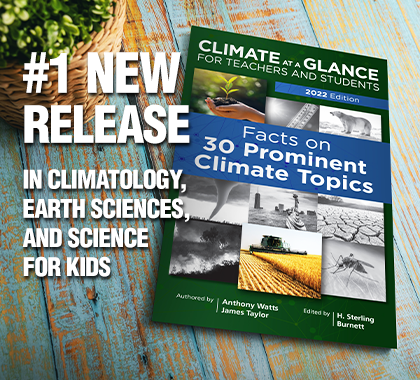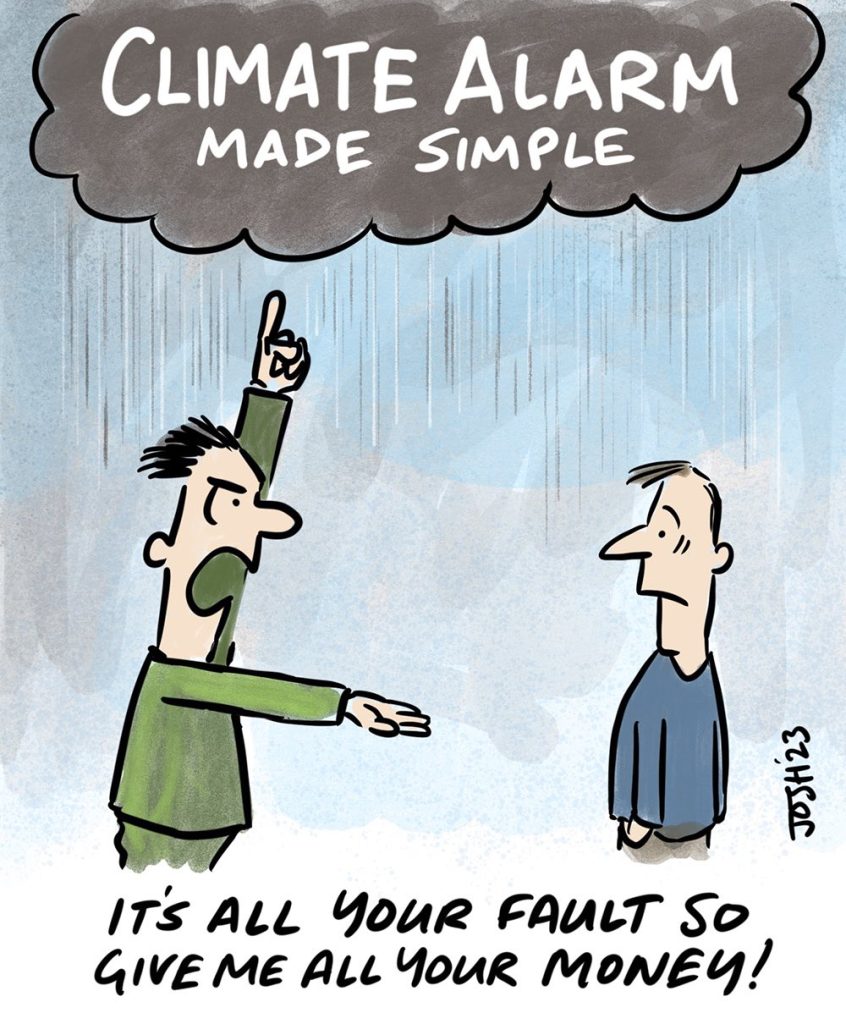YOU SHOULD SUBSCRIBE TO CLIMATE CHANGE WEEKLY.
IN THIS ISSUE:
- Study Suggests Causes of Climate Change Beyond CO2
- Podcast of the Week: The Folly of Electric Vehicles: Heartland’s Jim Lakely on the Cut Jib Newsletter Podcast
- Rock Weathering Not the Carbon Sink Once Believed
- Concerns Raised About Consensus Science and Censorship
- Manufacturers Face an EV Loyalty Problem
- Video of the Week: Debunking Way-out Climate Alarmism Videos
- Climate Comedy
- Recommended Sites
Miss Anything at Heartland’s Climate Conference? No Problem.

Study Suggests Causes of Climate Change Beyond CO2

Research recently published in the journal Atmosphere concludes that carbon dioxide is only one possible forcing factor driving recent climate changes, and probably not the dominant one.
Reviewing the literature since World War II, the author, Stuart Harris, Ph.D., a professor emeritus of geography with the University of Calgary, finds multiple other explanations have been offered in various studies at various times for recent climate changes, beyond today’s current bete noire, carbon dioxide.
Harris writes:
Atmospheric carbon dioxide is only suggested as a cause in one theory, which, despite its wide acceptance by politicians, the media, and the public, ignores the findings in other studies, including the ideas found in the Milankovitch Cycles. [Increased carbon dioxide] also does not explain the well-known NASA map of the changes between the global 1951–1978 and the 2010–2019 mean annual temperatures. The other theories by oceanographers, earth scientists, and geographers fit together to indicate that the variations in climate are the result of differential solar heating of the Earth, resulting in a series of processes redistributing the heat to produce a more uniform range of climates around the surface of the Earth. Key factors are the shape of the Earth and the Milankovitch Cycles, the distribution of land and water bodies, the differences between heating land and water, ocean currents and gateways, air masses, and hurricanes.
Harris notes that historical warming and cooling preceded changes in carbon dioxide concentrations. In addition, he points out that the recent modest increase in global average temperature began in the later part of the 19th century and early 20th century, before significant human greenhouse gas emissions, and that temperatures since then have risen and plateaued a couple of times even as carbon dioxide concentrations steadily increased.
As a result, he argues climate changes are now, and historically have been, driven by external factors like solar activity, and internal factors, such as Milankovitch cycles and how the Earth’s rotation moves fluids, and the way the Earth responds to “uneven solar heating of the surface of the Earth and the movements of the excess heat in the tropics towards the cooler polar regions, primarily by the movements of ocean currents, modified by the movements of air masses.”
Whether or not the factors Harris identifies are driving present climate change, two things we can say with some certainty about them: they impact the climate; and they are inadequately accounted for, or completely ignored, in climate model representations of the Earth’s climate and model outputs.
Source: Atmosphere
Get your Copy at Amazon TODAY!

Podcast of the Week
The other day Heartland Institute Vice President Jim Lakely was a guest on the Cut Jib Newsletter Podcast, part of the excellent and must-read Ace of Spades blog. Jim was invited on by hosts JJ Sefton and CBD, bloggers at the site, to talk about the folly of electric vehicles. It’s a favorite subject of Jim’s, and also of another great blogger at Ace of Spades, Buck Throckmorton. Have a listen.
Subscribe to the Environment & Climate News podcast on Apple Podcasts, iHeart, Spotify or wherever you get your podcasts. And be sure to leave a positive review!
Rock Weathering Not the Carbon Sink Once Believed

New research published in the journal Nature suggests that rather than being a carbon sink, the weathering of rocks is in fact a net emitter of carbon dioxide, adding an amount of CO2 to the atmosphere each year equal to or greater than that emitted by volcanic activity.
Describing the study, a news release from Oxford University posted on EurekAlert!, a website of the American Association for the Advancement of Sciences, states:
A new study led by the University of Oxford has overturned the view that natural rock weathering acts as a CO2 sink, indicating instead that this can also act as a large CO2 source, rivalling that of volcanoes. The results, published today in the journal Nature, have important implications for modelling climate change scenarios.
Over Earth’s history, carbon dioxide has been removed from the atmosphere and stored in the soil and the ancient remains of plants and animal, which under pressure and heat have formed carbonaceous sedimentary rocks.
Scientists have theorized that the “geological carbon cycle” helps to regulate the Earth’s temperature; for example, through chemical weathering, whereby rocks suck up CO2 when certain minerals are attacked by the weak acid found in rainwater, removing naturally occurring carbon dioxide.
This new study indicates that due to weathering, rocks are not a net carbon sink as previously believed, but rather are net carbon emitters. It finds that as rocks migrate from the Earth’s interior and the ocean floors to the Earth’s surface, as when mountains develop over time, it exposes the rocks to oxygen and water. The weathering that occurs releases an amount of stored carbon dioxide each year equal to the amount released by volcanoes.
This is important for a couple of reasons. First, research published in the past few years, discussed at No Tricks Zone, indicates that 10 times more carbon dioxide is emitted into the atmosphere by volcanoes annually than climate modelers assume/estimate as model inputs. Second, the weathering of rocks is currently unaccounted for in climate models and calculations of the sources of carbon dioxide. If the fracturing and weathering of rocks releases an amount of carbon dioxide equal to volcanoes, and volcanoes release 10 times more carbon dioxide than was previously assumed, rocks suddenly become a significant new source in the carbon cycle—a source not considered by scientists pushing the theory human greenhouse gas emissions are causing climate change.
Based on this discovery, the team of researchers are now examining “how changes in erosion due to human activities, alongside the increased warming of rocks due to anthropogenic climate changes, could increase this natural carbon leak.”
Sources: EurekAlert!; No Tricks Zone
Heartland’s Must-read Climate Sites



Concerns Raised About Consensus Science and Censorship

A paper published in the journal Entropy examines attempts to suppress scientific research skeptical of claims humans are causing a climate crisis. In particular, it responds to a recent editorial published in the journal Earth Systems Dynamics (ESD) in which the journal’s editors write that because consensus has now established as a fact that human greenhouse gas emissions are causing dangerous climate change, research questioning the consensus position should be rejected out of hand, without even giving the scientific courtesy of peer review or being considered for publication.
The authors of the Entropy paper, Igor Khmelinskii and Leslie V. Woodcock, climate researchers from Portugal’s University of Algarve with nearly 500 peer-reviewed articles published between them, argue the ESD article makes two factually incorrect assertions, and one suggestion that threatens to undermine scientific progress by subverting the scientific method.
Concerning the misstatements of fact, Khmelinskii and Woodcock write:
The … title … makes two scientifically incorrect assertions: (i) that the greenhouse-gas hypothesis, i.e., cause of global warming by ~1K in 1950-2020, is an established scientific truth, and (ii) that heat emissions [emphasis mine] from global fuel combustion are, by comparison, negligible. Both statements are inconsistent with, and illustrate editorial ignorance of, the laws of classical thermodynamics, of the limitations of the Earth’s global energy budget multivariate computer models, and of the known absorption and emission spectroscopy of carbon dioxide (CO2).
The authors note the theory that carbon dioxide emissions are causing present warming is just that, a theory, not an established fact. Its dominance of the present conversation about climate change is due to “consensus”—a political, not a scientific process—not through testing and confirmation as demanded by the scientific method. They also argue that thermodynamic analysis indicates human heat emissions, as opposed to carbon dioxide emissions, like the heat and water vapor from sources like pumps, engines, electrical turbines, steam generation, fossil fuel production, manufacturing of metals and materials, and presumably from artificial heat sources in urban areas (the urban heat island effect) are not, in fact, “negligible” contributors to the present measured warming, as claimed by ESD’s editors in their editorial.
Whether Khmelinskii’s and Woodcock’s analysis of the neglected accounting for heat fluxes produced by human sources of heat is correct, their point about CO2 driving climate change not being an established fact is certainly correct. Even more important, however, is their analysis of how scientific progress is threatened by scientific truths established by “consensus,” accompanied by the dismissal of the scientific method, and attempts to prevent skeptical climate analyses from being published, out of fear that it would give alternative views of why the climate is changing legitimacy.
Concerning this point, Khemelinskii and Woodcock write:
The scientific method of establishing truth requires hypotheses to be tested against experimental results by circumspective scientific scrutiny. Scientific knowledge cannot be established by consensus politics. We question the wisdom of a policy of rejecting articles that may disparage the greenhouse-gas hypothesis. By this criterion of science by consensus, … Nicholas Copernicus’s research … disput[ing] the prevailing consensus of the Ptolemaic hypothesis of a static Earth system, would have been rejected by Copernicus Publications.
The ESD editors cite, as an example, two recent articles, they say, that should have been rejected without peer review. Both articles, that contradict the greenhouse gas hypothesis, were peer-reviewed for sound science, and published by MDPI recently in Entropy. We find that Copernicus Publications peer-review policy, and this ESD editorial article in particular, are unethical. A policy of only publishing consensus science enhances an ascendancy of politically motivated subjective pseudoscience, causing a stagnation of our scientific understanding and description of Earth systems.
One of the research papers the editors of ESD say they would have rejected out of hand as not meriting even consideration for peer review was discussed in CCW 466. That paper presented research indicating the residence time of any molecule of CO2 entering the atmosphere is between five and 10 years, far shorter than the hundreds of years commonly asserted by those pushing the narrative human CO2 emissions are causing catastrophic climate change. Based on this analysis the author concluded the atmospheric concentration of CO2 was likely not stable at 280 ppm in pre-industrial times and that approximately 90 percent of all anthropogenic carbon dioxide emitted by humans has already been removed from the atmosphere, and thus can’t be driving dramatic climate change. This paper passed peer review, but because it presented a view that contradicts the “consensus” position on the residence time and impact of CO2 affirmed by the U.N. Intergovernmental Panel on Climate Change, ESD’s editors claim the research is wrong on its face and its analysis didn’t even merit scientific consideration.
Quashing alternative theories without even review and testing is not what the scientific method prescribes or how science progresses. By suggesting such treatment of research, it is the editors of ESD who are rejecting science. This suggests to me that ESD’s editors arguably don’t deserve to be the gatekeepers for a legitimate journal of scientific enquiry.
Source: Research Gate
EVs Becoming Uninsurable
In last week’s CCW I discussed the problem of insuring EVs and how it is impacting the costs and desirability of owning an EV. It seems automobile manufacturers making EVs (besides Tesla), face another problem, EV loyalty.
Nearly half of households with non-Tesla electric vehicles (EVs) made an internal combustion engine (ICE) vehicle their next auto purchase, according to a new by S&P Global Mobility (S&P) analysis. Whether those purchases were for replacement vehicles or additional vehicles is not specified. In either case, EVs were not their next purchase.
According to S&P “the fuel type loyalty rate for mainstream EV households was 52.1% through July of this year,” representing purchasers who remained loyal to EVs after buying their initial one.
It seems that many EV purchasers are making ICE vehicles their next choice because they have the advantage of lower prices, more payload and reliability, and vastly superior infrastructure.
The report also found an overall decline in non-EV owner’s willingness to purchase an EV, with overall consumer consideration for buying an EV,” dropping to 52 percent from a high of 81 percent, suggested in survey in 2021.
“Pricing, infrastructure, and range were the top three reasons consumers listed for not purchasing an EV,” S&P said. “For some consumers, having a traditional ICE or hybrid vehicle is a way to hedge against some of these obstacles.
“A large chunk of buyers went to Ford truck and SUV models in both ICE and hybrid powertrains, suggesting that vehicle type and capability were more important than the fuel used,” S&P concluded.
This data suggests there may be problems ahead for both upstart manufacturers, like Rivian, and traditional automobile manufacturers pushing to phase out ICE production in favor of EV’s, alike. Rivian’s stock price has tanked, and Ford announced it lost $4.5 billion on EVs in 2022, which is one reason why it announced it was halting production of its electric trucks for the time being, which were piling up unsold on dealer’s lots.
Sources: Repairer Driven News; S&P Global
Video of the Week
On this episode of Climate Change Roundtable, host Anthony Watts and panelists Linnea Lueken and H. Sterling Burnett debunk a video taking the corporate position on climate change. The video, titled “Climate Change” from the Sci Show channel on YouTube features the host on screen alternating between ill-informed science takes and ad hominem attacks.
Tune in every Friday at 1 p.m. ET to watch the Climate Change Roundtable LIVE on The Heartland Institute’s YouTube Channel, and also on Rumble.




























